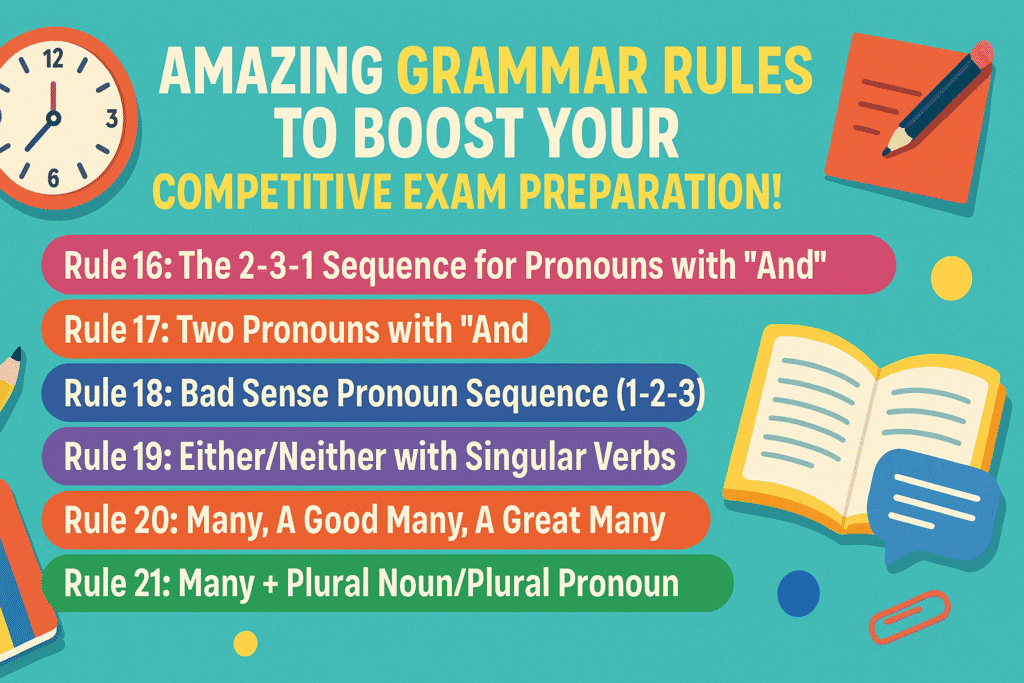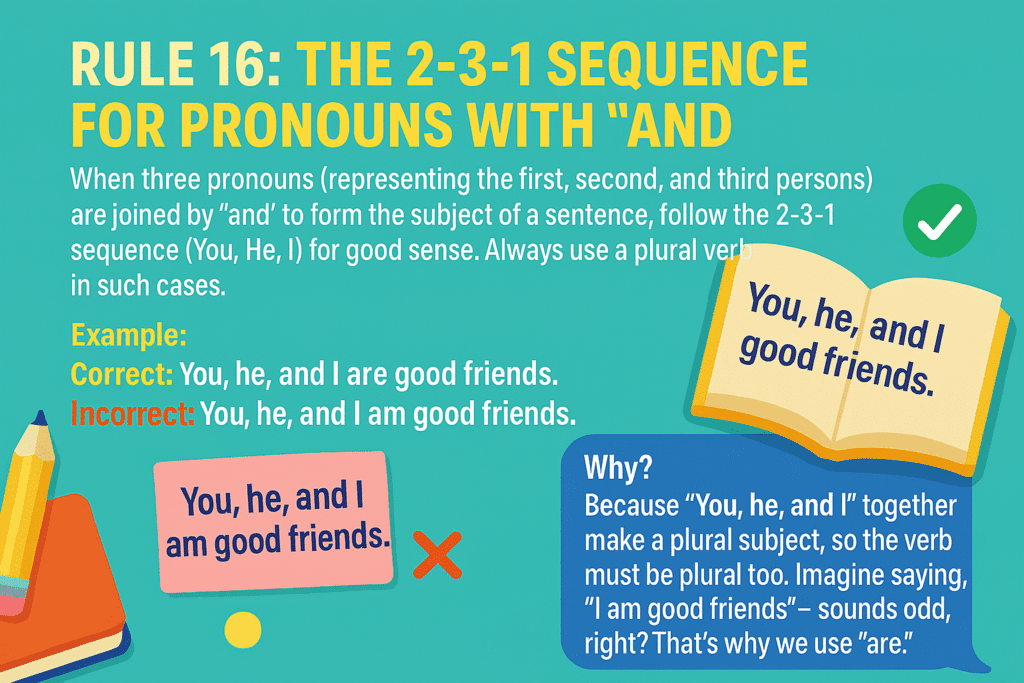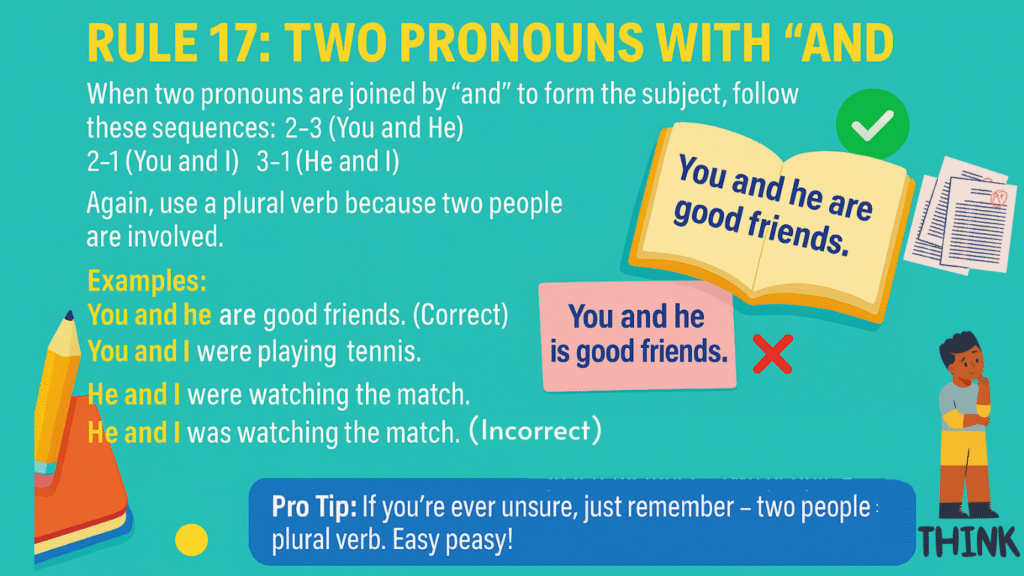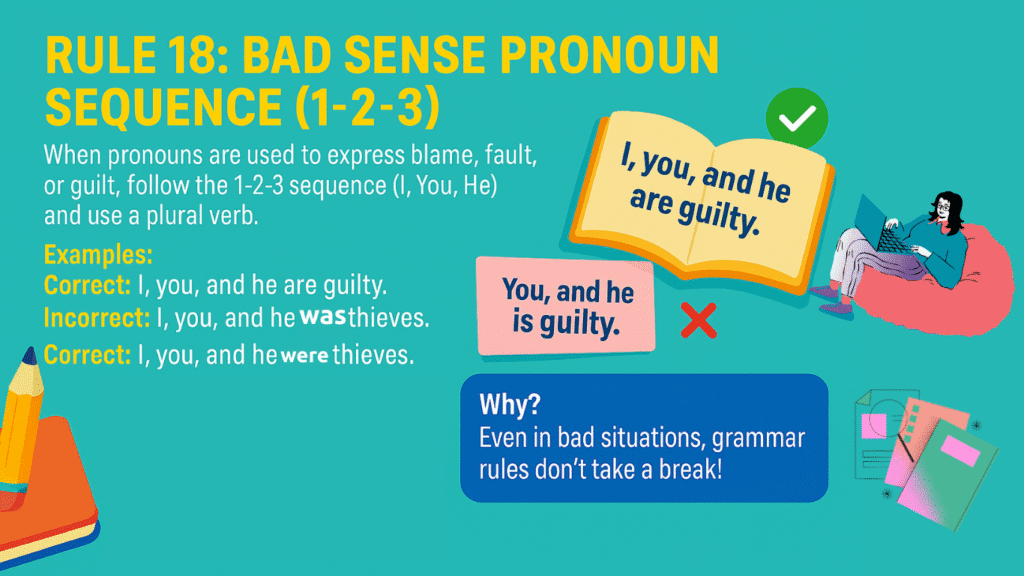
Welcome back to our series on English grammar rules designed to help you ace competitive exams like PSSSB, PCS, Punjab Police, Punjab Patwari, Excise Inspector, and more! If you haven’t checked out the previous parts, make sure to do so before diving into this one. Today, we’ll explore more grammar rules that frequently appear in exams and often confuse aspirants. Let’s get started with a mix of rules, examples, and a pinch of humor to keep things interesting!
Table of Contents
Rule 16: The 2-3-1 Sequence for Pronouns with “And”

When three pronouns (representing the first, second, and third persons) are joined by “and” to form the subject of a sentence, follow the 2-3-1 sequence (You, He, I) for good sense. Always use a plural verb in such cases.
Example:
- Correct: You, he, and I are good friends.
- Incorrect: You, he, and I am good friends.
Why?
Because “You, he, and I” together make a plural subject, so the verb must be plural too. Imagine saying, “I am good friends” – sounds odd, right? That’s why we use “are.”
Rule 17: Two Pronouns with “And”

When two pronouns are joined by “and” to form the subject, follow these sequences:
- 2-3 (You and He)
- 2-1 (You and I)
- 3-1 (He and I)
Again, use a plural verb because two people are involved.
Examples:
- You and he are good friends. (Correct)
You and he is good friends. (Incorrect) - You and I were playing tennis. (Correct)
You and I was playing tennis. (Incorrect) - He and I were watching the match. (Correct)
He and I was watching the match. (Incorrect)
Pro Tip: If you’re ever unsure, just remember – two people = plural verb. Easy peasy!
Rule 18: Bad Sense Pronoun Sequence (1-2-3)

When pronouns are used to express blame, fault, or guilt, follow the 1-2-3 sequence (I, You, He) and use a plural verb.
Examples:
- Correct: I, you, and he are guilty.
- Incorrect: I, you, and he is guilty.
- Correct: I, you, and he were thieves.
- Incorrect: I, you, and he was thieves.
Why?
Even in bad situations, grammar rules don’t take a break!
Rule 19: Either/Neither with Singular Verbs
When “either” or “neither” is used as the subject, always pair it with a singular verb.
Examples:
- Correct: There are two trial rooms here, but either is occupied.
- Incorrect: There are two trial rooms here, but either are occupied.
- Correct: There are two girls in the class, but neither is intelligent.
- Incorrect: There are two girls in the class, but neither are intelligent.
Fun Fact: “Either” and “neither” are like picky eaters – they only go well with singular verbs!
Rule 20: Many, A Good Many, A Great Many
When “many,” “a good many,” or “a great many” is used as the subject, always use a plural verb.
Examples:
- Correct: Many are absent from the club.
- Incorrect: Many is absent from the club.
- Correct: A good many of us have gone to Chandigarh.
- Incorrect: A good many of us has gone to Chandigarh.
Pro Tip: Think of “many” as a group – and groups always need plural verbs!
Rule 21: Many + Plural Noun/Plural Pronoun
When “many,” “a great many,” or “a good many” is followed by a plural noun or pronoun, use a plural verb.
Examples:
- Correct: Many officers have passed the fitness test.
- Incorrect: Many officers has passed the fitness test.
- Correct: Many of the thieves were arrested.
- Incorrect: Many of the thieves was arrested.
Why?
Because “many officers” or “many thieves” are clearly plural subjects. Don’t let the verb betray you!
Grammar rules might seem daunting at first, but with consistent practice, they become second nature. Try writing your own sentences using these rules and share them in the comments below. If you make a mistake, don’t worry – that’s how we learn!
And remember, grammar isn’t just for exams; it’s for life. Whether you’re writing an official report or texting a friend, these rules will help you communicate clearly and confidently.
Stay tuned for the next part of this series, and until then, keep practicing and keep smiling!
This article is brought to you by RankersChoice.com – your one-stop destination for exam preparation tips, tricks, and humor!
FAQs – Because Doubts Deserve Answers!
Q1. Why is the 2-3-1 sequence important in grammar?
A1. The 2-3-1 sequence (You, He, I) is used to maintain politeness and logical order in sentences. It’s a rule of thumb to avoid sounding awkward or rude.
Q2. Can I use “either” with a plural verb?
A2. No, “either” and “neither” are always paired with singular verbs, even if they refer to two things.
Q3. What’s the difference between “many” and “a great many”?
A3. Both mean “a large number,” but “a great many” emphasizes a significantly larger quantity. Both, however, take plural verbs.
Q4. How can I remember these rules easily?
A4. Practice by creating your own sentences and applying these rules. The more you use them, the more natural they’ll feel.
Q5. Can ‘Many’ and ‘Many of’ be used interchangeably?
A5. Not always! ‘Many’ is followed by a plural noun, while ‘Many of’ requires a plural pronoun or determiner.
Q6. Why does ‘Many’ always take a plural verb?
A6. ‘Many’ refers to multiple things or people, so the verb must be plural to match.
Q7: What is the correct order of pronouns in a sentence?
A7. In positive sentences, the order is 2nd person → 3rd person → 1st person (231 rule) (e.g., You, he, and I). In negative sentences (blame, crime, guilt, etc.), the order is 1st person → 2nd person → 3rd person (123 rule) (e.g., I, you, and he).
Q8: Can I use “he and I” or “him and me”?
A8 : It depends on the function in the sentence!
As subjects → He and I went to the store.
As objects → The teacher scolded him and me.
